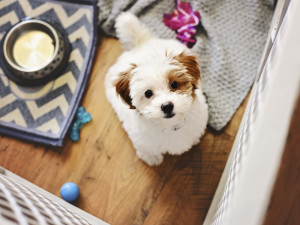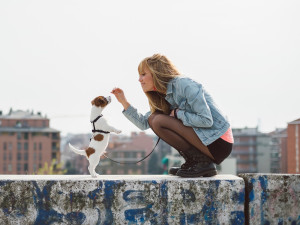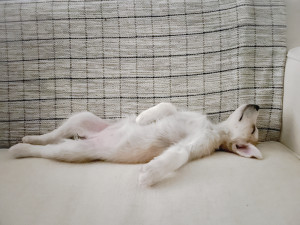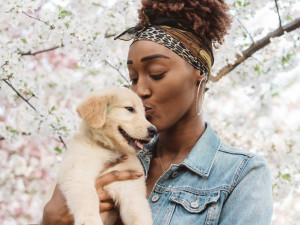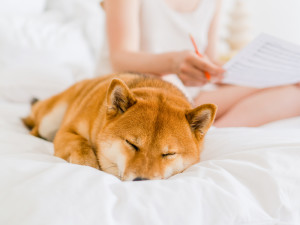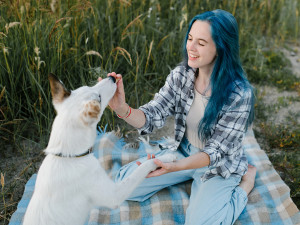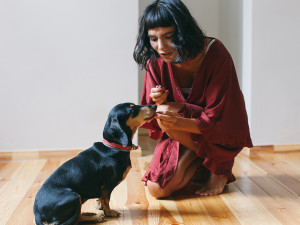Crate-Train Your Puppy at Night in 7 Easy Steps
It’ll make life easier for both of you—eventually.
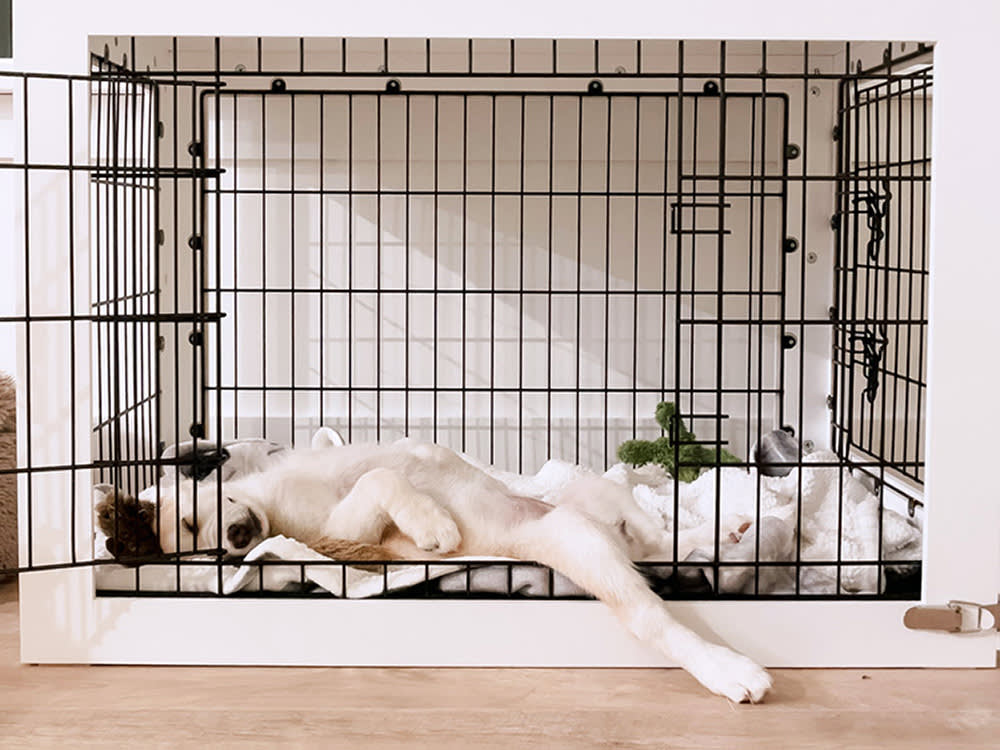
Share Article
In this Article:
Why Is Nighttime Crate-Training Important? Nighttime Puppy Crate-Training Tips and Tricks How to Crate-Train a Puppy at Night Where Should My Puppy’s Crate Be At Night? What if My Puppy Whines in the Crate? How to Handle Nighttime Potty Breaks What to Do When You Want to Give Up Nighttime Crate-Training Your Puppy
If you’re a new puppy parent, the idea of putting your pup in a crate at night may seem a little odd, or even cruel. Aren’t puppies made for cuddling? But in fact, crate-training a puppy at night isn’t cruel at all — and their crate may even become the place they feel safest at night. Getting them used to it may take some time and effort, though.
To get your puppy comfortable in their crate, start by introducing the crate in a positive manner. Place treats or toys inside to help your pup make a positive association with the space, and add a soft blanket or bedding. When it’s time for bed, place the puppy in the crate with a reassuring tone and a favorite toy. Make sure the crate is in a quiet, darkened room to encourage relaxation. Consistency is key; maintain a regular bedtime and bathroom schedule to help your puppy adjust.
Keep reading for more information, step-by-step instructions, and answers to frequently asked questions about crate-training.

Why is nighttime crate-training important?
When your puppy is brand new and just learning to navigate their way around their new home, a crate helps prevent them from getting into mischief. “A crate can be a great option to help keep your puppy safe when you can’t watch them,” says Caroline Wilkinson, certified animal behaviorist and founder of Barket Placeopens in new tab. Here are a few other reasons you'll want to crate-train your puppy so they're comfortable in their crate at night.
Crates provide safety and security.
Far from being a punishment, a crate is a safe space. When you make it a cozy, welcoming place for your pup, they'll be happy to be tucked away in their crate. “I like to use terms such as den, bedroom, or rest zone when talking about a crate, as it gives us a much more positive idea of how this tool should be used,” Wilkinson says. “It should never be used as a form of punishment to shut your dog away.”
Crates prevent destructive behavior.
An unattended puppy can get into mischief, whether it's because they're anxious, curious, or just plain bored. A crate doesn’t only keep your puppy safe, it keeps your stuff safe, too.
Crates can help with nighttime potty training.
A puppy who is left to roam in the night may wander around and leave you a little surprise to find when you wake up. Keeping your puppy in their crate at night can help teach them to hold it until morning. Puppies don't like peeing where they sleep (just like us!), so they'll do the best they can to wait until you take them out for a walk.
You can sleep soundly knowing your puppy is safe.
When your puppy is brand-new and just learning to navigate their way around their new home, a crate helps prevent them from getting into trouble while you’re sleeping. “A crate can be a great option to help keep your puppy safe when you can’t watch them,” Wilkinson says.
Nighttime puppy crate-training tips and tricks
Not sure where to start? The following tips and tricks will help you crate-train your puppy effectively:
Line your puppy's crate with soft bedding and blankets — but make sure to avoid using anything they might be tempted to chew up or eat.
Put a favorite toy in the crate, to keep your puppy occupied and engaged when they're awake in there.
Cover the crate at night, to make a cozy, dark environment that encourages sleep.
Tire your puppy out with a long walk or a play session before putting them in the crate for bed.
Make sure to give your puppy a bathroom break right before they head into their crate for the night.
Get into a routine, so your puppy knows when crate time is coming up. With time, they'll adjust, and even look forward to being in the crate.
How to crate-train a puppy at night
Ready to tackle crate-training? Here’s how to crate-train your puppy, in seven easy steps:
1. Choose a crate.
First things first: You’ll need to find a crate that’s the right size for your puppy. They should be able to stand up, turn around, and lie down comfortably in the crate. Be sure to take into account how big they’re going to get — your pup may be tiny now, but you want the crate to last as they grow.
Crates come in many different styles, and while there’s nothing wrong with getting a hand-me-down crate from your local Buy Nothing group or buying a no-frills version that fits your budget, if you can afford to spend more, it may be worth it. “Consider investing in a fancy crate,” says trainer Ivan Petersel, founder of Dog Wizardryopens in new tab. He adds that if a wire crate is what is in your budget, that’s OK, but speak with a trainer and vet about which brands are safest, especially for young puppies.
Depending on the size of your home, you may want an extra crate (or two!) as well. “Often, I will have more than one crate in the house,” Petersel says. “At least one of them is in a high-traffic area where the dog can see people coming and going.
2. Make the crate comfortable.
The crate is going to be your puppy’s bedroom, at least for a while, so do it up accordingly. “Fill the whole crate with comfortable bedding and avoid splitting the space into half sleeping/half toilet zone,” Wilkinson says.
You can give your pup meals in the crate, and they should also have access to water. “During the daytime (and overnight during hot weather), ensure there is always water available within the crate. A hook-on bowl is useful to stop your puppy sitting in it.”
3. Let your puppy get used to the crate.
To start out, put the crate in a spot where you and your puppy hang out the most, whether that’s your living room, kitchen, or bedroom. Having the crate in the middle of the action helps your dog associate it with good times. “Place the crate somewhere where your dog can feel a part of family life, but that isn't too busy or noisy a space to relax in,” Wilkinson says.
Leave the crate door open so they can nose around and explore, and put some toys and a blanket in the crate, as well as food and water. “Give the best things in life inside the crate!” Petersel says. He recommends high-value treats, a frozen treat, or anything that’s safe for them.
4. Don’t close the crate door until your puppy is ready.
Again, you want to make sure the crate feels like a secure and fun place to be — and that means taking it slowly when it comes to shutting the door. “Leave the door open and toss treats in to give your puppy the experience of running in and running out,” Petersel says. “Don’t let your dog think that the door closes every time they go in. When you do start closing the door, do it in increments. Gradually increase the amount of time the door is closed.”
How do you know when your puppy is ready for you to close the crate door? “Avoid shutting the door to the crate until your dog is comfortably going to the crate of their own accord,” Wilkinson says.
5. Create a puppy crate-training schedule.
People generally function better with routine, and that goes for dogs, too. Put your puppy in the crate for naps and at bedtime at consistent times, even if you’re home and available to keep an eye on them.
“When your puppy falls asleep naturally anywhere around your home, carefully lift them and place them in their crate so that they wake there feeling relaxed,” Wilkinson says. Before you know it, your puppy will be curling up in the crate all on their own.
6. Be strategic about crate time.
When your puppy is ready to be left alone in a closed crate, keep a couple of things in mind. “Make sure the dog has plenty of exercise before going in the crate,” Petersel says. This helps encourage them to curl up and relax when they’re in the crate. Don’t put them in the crate just before you walk out the door, either, he urges: “If you are leaving the house, crate the puppy 30 minutes before leaving. Many people crate their dog right before they leave. This creates a bad association.”
When you get home, don’t rush to let your puppy out, either (unless they’re desperate to go to the bathroom — you don’t want them to have an accident, obviously). “If you take the dog out right when you get home, the puppy is likely whining and clawing to get out,” Petersel says. “Don’t nurture anxiety by letting the dog learn that having meltdowns earns them freedom.” He suggests 30 minutes in the crate before you leave and after you get home, if possible.
7. Never use the crate as punishment.
It can't be said enough: crate time is not a punishment. Your puppy should feel safe and comfortable when they're in their crate. It should feel like a safe haven for them — a place to rest, relax, and maybe even dream about how much fun they have with you, their trusted parent.
Where should my puppy’s crate be at night?
At least at first, put your puppy’s crate near your bed so you can keep a close eye on them and be available if they need to go out to pee or poop. If you’d rather not have them sleeping in your room, you can put the crate right outside in the hall. You can gradually move it further away once the puppy gets used to the crate and needs to go out less often.
Should I cover my puppy’s crate at night?
Just like you pull your shades closed at night, many experts recommend covering the crate when your dog is sleeping, to foster good rest and keep from disturbing them. At bedtime, you can cover your puppy’s crate with a blanket to signal that it’s time for bed. Leave one side uncovered so you can keep an eye on your puppy, or if they seem upset with the crate fully covered.
What should I do if my puppy whines in the crate?
Crate-training a puppy at night may involve some amount of crying (the puppy, not you — though many a pet parent has shed some tears over the sound of their puppy whining). But Petersel warns against letting your puppy “cry it out” in their crate. “When puppies whine, they are communicating something. It’s important to listen to your dog to understand what they’re saying,” he says. “It may be boredom, excitement, anxiety, illness, a need to potty and more.”
What’s the best way to help a puppy stop whining?
Petersel encourages puppy parents to reframe their state of mind. “Instead of thinking ‘how do I stop the whining,’ reflect on the root causes. Are all of your dog’s needs met? Have you given them enough exercise and made sure it wasn’t a pain or physical issue?”
Automatically opening the crate door isn’t necessarily the answer. “This may lead them to think that whining is the way out,” Petersel says. He encourages dog parents to reward the moments when their puppy is not crying, as well. “Acknowledging calm states of mind is more important than focusing on whiny moments. Show the puppy that calmness is the key to your heart.”
How to handle nighttime potty breaks
Humans often have to get up to use the bathroom at night, and so do puppies. To reduce the need for nighttime walks (especially when leash training is still a work in progress), keep the following tips in mind, Petersel says.
Always take your puppy out for a bathroom break before they go into their crate (and remember, they should be heading into the crate 30 minutes before you leave, if you’re leaving).
Puppies can generally hold their bladder for one hour for every month of age. “For example, if they are two months old, they’ll need to come out before two hours. If they are three months old, they can only be in a crate for three hours max.”
Made the crate as accident-proof as possible. “Don’t get a giant crate where they can go to the back of it and have an accident. If you do get a large crate, then section it off so they don’t have too much room,” Petersel says.
What to do when you want to give up nighttime crate-training your puppy
Nighttime crate-training is like any other type of training: It takes patience, consistency, and time. But don't throw in the towel, even if your puppy is having a hard time and you're feeling frustrated. It's important that your puppy feels safe and comfortable in their crate. With a little more work, you'll get there.
Consult a professional trainer if you're having trouble even after trying all of these tips, and have a chat with your vet if your puppy seems uncomfortable and you suspect a health issue could be at play. Chances are, you and your puppy both just need time to settle into a routine.
Final thoughts: Nighttime crate-training your puppy
Making your puppy’s crate cozy is key to helping them feel comfortable, according to Petersel. “Teach them to love the crate, not simply tolerate it,” he says. That means plenty of blankets (try sleeping with one before you put it in the crate so it smells like you), toys, and an easily accessible water dish.
Bottom line
Crate-training your puppy at night is beneficial for of you. You may sleep better, and they'll stay out of trouble.
A crate provides a safe haven for your puppy; being in the crate is not a punishment.
Always make sure your puppy's needs are met when they are in the crate. If they cry or whine, figure out what's wrong, rather than ignoring them. Don't let them “cry it out” in their crate.
FAQs
How long can you keep your dog inside the crate?
This depends on several factors, including how old your dog is and how much bladder control they have. A young puppy won't be able to stay in the crate for more than a couple of hours, while an older dog may be fine overnight.
What should I do if my puppy barks in their crate at night?
Check to make sure their physical needs are met. If your puppy has had plenty of food, water, exercise, and doesn’t need to pee or poop, covering the crate with a blanket may help alleviate their anxiety.
Consider getting professional help if the barking continues. “It is important to note that not all dogs will find a crate relaxing to be in, and if you see signs of them being distressed while confined, speak to a force-free trainer to help guide you through the process,” Wilkinson says.
Can I crate my puppy for their first night home?
The sooner you start training your puppy to love their crate, the better. “When a dog is young, they are unpredictable,” Petersel says. “For that reason, there should not be any blind spots. When the dog is older and trustworthy to be alone, less management is needed.
Remember, too, that a crate is a haven, not a punishment. Many dogs actually like to be crated, Petersel says. “A crate satisfies a dog’s natural instinct to be in a den.”
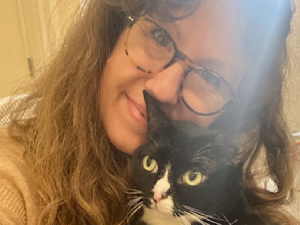
Elizabeth Laura Nelson
Elizabeth Laura Nelson is a writer and editor based in Brooklyn, New York, whose work has appeared in The New York Times, Jenny, Best Life, YourTango, Elite Daily, and more. She focuses her work on relationships, health and wellness, midlife, and lifestyle. As a child, Elizabeth was scared of cats (claws and teeth, yikes) but she has since gotten over her fear and now shares her home with three sweet and gentle feline companions who make life better (and cuddlier) every day.
Related articles
![a puppy sprawled out on the couch sleeping]()
Is Your Puppy Sleeping Enough?
Four signs your puppy is ready for a nap.
![woman draped in an orange blanket holds a black-and-white puppy]()
5 Development Stages You Should Know When You Get a Puppy
It’s like What to Expect When You’re Expecting, except add “four little paws to run around your house” to the title.
![Shiba inu dog sleeping in bed]()
My Dog Sleeps All Day—Is That Normal?
Dogs need more sleep than humans. Here’s how much is healthy.
![girl with blue hair starting puppy training with white dog]()
Puppy Training 101: How to Train a Puppy
You gotta start somewhere.
![woman gives small black dog treat for sitting]()
Your Dog Should Do This 30-Day Training Challenge
It’s like your 30-day yoga challenge — except with way more training treats.

